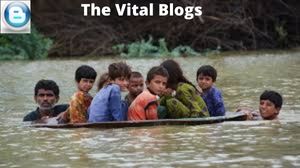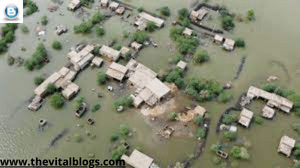
Will Pakistan’s Economy Be Washed Away by Record Floods? Record floods in Pakistan have caused devastation across the country, destroying over 1 million homes and displacing millions of people. At first glance, it may seem that economic progress in Pakistan is being washed away with the flood waters, too. But as the nation begins to recover from the devastating effects of the worst flooding in its history, experts say there are reasons to be optimistic about the future of its economy. Here are some ways Pakistan can bounce back from floods and make up for lost time and money.
Damage estimates in billions
Damage from the flooding is not yet certain, but the country’s macroeconomic stability will be put to the test if reconstruction is badly handled. According to Capital Economics in London, current figures for repairs to damaged or destroyed infrastructure are at $8 billion. This would bring total losses in property and assets across Sindh province alone up to $12 billion, making it one of the most expensive natural disasters on record. The other big headache will be an estimated 1.5 million displaced people now living with no reliable income, so a cash injection may also be needed. Moody’s has downgraded Pakistan’s credit rating because of the floods’ impact on economic growth. Moody’s estimates that gross domestic product (GDP) growth will drop from 5% before the disaster to around 3% during 2009, as foreign reserves dwindle and capital flight increases. That said, because only about 2% of GDP came from exports before the floods — compared with nearly 50% coming from remittances — rebuilding should have a small impact on imports.
Insurance claims could hit $1 billion
In late July, record floods hit the country and continued for a month. Rescuers are finally completing their search of two northern provinces that had been cut off for days as flooding swept away bridges and demolished houses. The death toll was at least 550 on Tuesday with about 2 million people marooned in homes or refugee camps. The deluge is expected to wreak havoc on the country’s farming sector and threaten jobs in construction industries like textiles. As the economy begins to bounce back from the floods, its institutions need to be strengthened to counter the potential social effects such as crime, a wave of homelessness and more kidnappings. Law enforcement officials estimate that the government could spend $4 billion to rebuild infrastructure alone, with another $1 billion needed for compensation to victims and emergency relief funds.
The government’s losses could exceed $2 billion
Record floods in South Asia are continuing to disrupt the country. In particular, flooding in neighboring Pakistan has killed at least 81 people and damaged more than a million homes, with thousands more set to be destroyed. As bad as this disaster is for the people of South Asia, it also means that money that could have been spent on rebuilding their countries’ economies will now be redirected to flood-related needs. The severity of this catastrophe will likely impact trade, which will negatively affect economic activity and increase inflation. Governments may use dollars borrowed from the International Monetary Fund (IMF) to pay for emergency imports, but those dollars can’t generate economic activity.
Tourism and exports affected most
The floods have had their most serious impact on the rural areas in Sindh, which account for as much as 60% of the population. Tourism has been hard hit as well with some 34 historic sites and four luxury hotels being destroyed or damaged. Efforts to contain cholera epidemics are being hindered with 13% of health facilities damaged or closed due to flooding. Relief supplies are also getting in more slowly now that the floodwater is higher.
The flood could have an enormous economic impact on Pakistan. The World Bank estimates that GDP in 2009 was $133 billion with a growth rate of 6.3%. It projects growth at 7% for 2010 and an inflation rate of 6.6% for 2011. Inflation is projected to fall back to 3.2% in 2012, according to its latest outlook report, published in April 2011.
Investors hit hard as stocks plunge
After a record breaking period of flooding, the financial outlook for many investors is looking dismal. The water has inundated and shut down many factories. Industrial production has dropped about 20%. And infrastructure development will likely stall due to energy shortages. With exports being reduced and foreign currency reserves drying up, Pakistan’s economic situation could quickly deteriorate and take years to recover from as factory owners may have to close or lay off workers. For now, those at risk are international companies that have lent money to help the Pakistani textile industry grow, such as Adidas and Levi Strauss.
Businesses shut down
The Asian Development Bank (ADB) released a statement that the floods have severely disrupted life and economic activity in the country, preventing people from working or attending school. Tourism has also taken a huge hit because of increased security risk at airports and general lack of infrastructure in many of the affected areas. The ADB estimates that agricultural output has been reduced by 40%. This will not only affect rural livelihoods but it will lead to food shortages because an overwhelming number of farmers have lost their crops due to flooding. This makes it even more difficult for humanitarian organizations to help those in need given how many barriers there are. Furthermore, because there is so much devastation surrounding this disaster, it is becoming increasingly difficult for Pakistan to receive aid from other countries.
Unemployment increases dramatically
Pakistan has been struggling with a constant stream of economic problems, and after the widespread flooding in late 2010, many experts worry that the country may be in for a rough period. We think these floods will knock 1.3 percent off economic growth, says Khalid Saeed, executive director of Economic Research Institute of the Karachi Chamber of Commerce and Industry. The population is already depressed because of unemployment and poverty. According to Saeed, about 16 million people out of Pakistan’s population have jobs; he believes that this number may drop as low as 10 million if more floods are experienced over the next five years.
CONCLUSION
After devastating floods in the region, it is important to be aware of how they will impact the economy. The floods have had an effect on three sectors: manufacturing, services and agriculture. Manufacturing as a sector was the worst hit; 80% of manufacturing facilities were damaged or destroyed in the flooding with raw materials not coming in and work stoppages. The tourism industry has also been impacted; there are worries that people will not want to visit the country when they know it is still struggling to recover from such devastation. In terms of employment, an estimated 30 million workers are facing job insecurity, with reduced remittances from migrant labour which amounted to 1/3rd of GDP (US $ 12 billion) for Pakistan and affects 3 million families.
